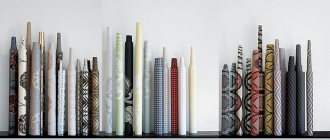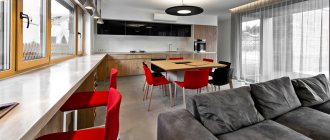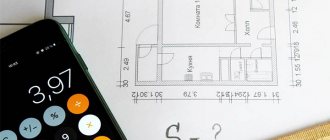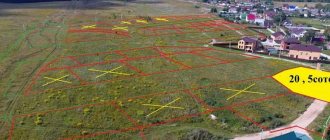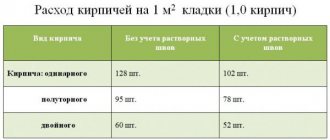Working with slab materials requires correct calculations that affect the reliability of the resulting surface; any inaccuracies can lead to deformation and even collapse of the structure. The weight of a sheet of drywall is determined taking into account the characteristics of a particular type and the main technical indicators of the material.
This parameter is influenced by the following factors:
- Size. The most popular are standard sheets with a length of 200–250 cm and a width of 120 cm. Thickness comes in 6.5, 9.5 and 12.5 mm, with options ranging from 15 to 22 mm.
- Application area. Products are conventionally divided into groups depending on the scope of use: wall, ceiling and arched. Gradation is most often based on the dimensions of the product, since the load for each surface must be selected correctly.
- Type of drywall. There are three main product modifications: regular, moisture-resistant and fire-resistant. There is also a universal variation - GKLVO. The performance characteristics of materials vary: special products include additional components that affect the weight of the slab.
Drywall with different characteristics differs not only in the color of the shirt, but also in the weight of the sheet.
Some differences may be observed among different brands and brands, but all parameters must be based on approved state standards and technical production conditions.
How many sheets of drywall are in 1 pallet?
We constantly have the following assortment of drywall on sale:
| Purpose | Name of GKP (standard size) | Number of sheets per pallet |
| Plasterboard ceiling | GKP 9.5 x 1200 x 2500 mm | 63 |
| Drywall wall | GKP 12.5 x 1200 x 2000 mm | 51 |
| GKP 12.5 x 1200 x 2500 mm | 51 | |
| GKP 12.5 x 1200 x 3000 mm | 51 |
How to correctly calculate the quantity for installing drywall on the ceiling and walls of a room?
A standard sheet has an area of 3 square meters. meters. By manually measuring the walls, you need to calculate their area and subtract the area of windows and doors from the total area. Then the resulting number (if necessary) is rounded up and divided by the area of the standard sheet.
Let's say the height of the walls is 2.7 meters. The size of the room is 2.5 by 3 meters. The size of the window is 1.5 by 1.5, and the door is 2 by 1.5 meters.
Calculate the perimeter of the walls of the room
: (2.5+3)x2=11 meters. We determine the area of the walls: 11x2.7 = 29.7 square meters. meters.
Determining the area of the door
: 2x1.5=3 sq. meters.
Calculate the window area
: 1.5x1.5=2.25 sq. meters.
Working area
: 29.7–(3+2.25)=24.45 square meters.
The area of the walls is divided by the area of the standard sheet: 24.45/3 = 8.15 (sheet).
The correction factor is taken into account!
- for rooms up to 10 sq. meters it is 1.3;
- from 10 to 20 square meters the coefficient is 1.2;
- for large rooms – 1.1.
In the example above, you need to use a coefficient of 1.1, that is, 8.15 multiplied by 1.1. We get 8.965. The result is rounded up. “Extra” drywall will be useful in case of errors or for further repairs in other rooms. That is, you need to purchase 9 sheets.
On a note
. Calculations can be carried out taking into account any size (area) of plasterboard sheet.
For covering a balcony with plasterboard (side height 1.5 meters), small sheets 1.5 meters long and 0.6 meters wide are ideal. Or a standard-width plasterboard sheet three meters long, cut in half.
How to transport drywall correctly so as not to damage it
- Plasterboard sheets are transported only in a horizontal position. They can be stacked or stacked. In this case, the sheets are placed on the pallet with the front side inward.
- This material is quite brittle. Extreme care must be taken when loading and unloading.
- To transport small quantities of drywall, you can use the trunk of a car (after laying timber on it every 30 centimeters) or a small truck.
- In the back of a truck, the sheets must be laid on a clean floor. You cannot place other building materials on top, such as bags of cement or cans of paint. It is best to make a pallet for the sheets from bars, and cover the entire package with wrapping paper or polyethylene on top, thereby protecting the building material from dirt and dust.
Secret devices for conveniently carrying plasterboards
When carrying plasterboard sheets, carrying handles are a great help; they can only be used in pairs.
When transferring, a sheet (or two sheets) is held with your free hand. This transportation option is intended for private houses and apartments. For large construction sites, equipped trolleys with supports are more suitable.
How many people do you need to carry?
With all the variety of plasterboard sheets, standard and waterproof types are most often used. Arched ones require the participation of a specialist in installation. But in any case, you can’t do without help. Therefore, feel free to involve at least one or two family members in the transportation and installation. Good luck with your renovation!
Drywall is used to form additional structures indoors: partitions and small architectural forms in the interiors of buildings. Wall and ceiling cladding can be covered with various types of finishing. The only exception is ceramic tiles due to the heavy load.
- bodily - standard (gypsum plasterboard);
- blue – moisture resistant (GKLV);
- red – fireproof (GKLO).
Gypsum sheet sizes
The weight of the gypsum board is related to its area and thickness. All over the world there are generally accepted standards of dimensions:
- Length – from 2 to 4 m.
- Width – from 1.2 to 6 m.
- Thickness from – 6 to 24 mm.
Depending on its purpose, it must be of a certain thickness. To create arches and small architectural forms, 6.5 mm is used; 9.5 mm cladding is installed on suspended ceilings; 12-12.5 mm is used on walls. In some cases it reaches 24 mm.
How much does the leaf weigh?
It is important to take this into account when installing a suspended ceiling and horizontal hanging volumetric structures, since the mass of the gypsum board will be a direct load on the supporting frame.
By multiplying the height, width and thickness of the slab, the volume of gypsum is obtained. The product of these two indicators makes it possible to find out what the mass of the desired piece is.
| Size, m | Thickness, mm | ||
| Weight, kg | |||
| 6 | 9,5 | 12,5 | |
| 1.2x2.0 | 12 | 18 | 23 |
| 1.2x2.5 | 15 | 22 | 29 |
| 1.2x3.0 | 18 | 27 | 35 |
The weight of a standard sheet of drywall will differ slightly from moisture-resistant and fire-resistant cladding. This is due to various additives to the structure. To find the exact figure, correction factors are used:
- K 1 = 0.01 – takes into account cardboard;
- K 2 = 0.01 – moisture-resistant stabilizers;
- K 3 = 0.015 – fire-resistant additives.
How to determine mass?
Let’s say that to install cladding in a bathroom, you need to install moisture-resistant Knauf slabs measuring 2500x1200x12.5 mm on the ceiling. The specific gravity of gypsum ranges from 760–780 kg/m3. The volume will be equal to 2.5x1.2x0.0125 m = 0.0375 m3. The average specific gravity is taken to be 770 kg/m3. The calculation takes into account K 1 = 0.01 and K 2 = 0.015.
Using the data obtained, we obtain the weight: 0.0375 m3 x 2300 kg/m3 + (0.0375 x 770) x 0.01 + (0.0375 x 2300) x 0.015 = 29 kg. Using this calculation method, you can always find out how much drywall weighs.
Price
Knauf products are of high quality. Along with the German manufacturer, Gyproc occupies a significant segment in the Russian building materials market. The corporation has 65 factories; mineral raw materials of excellent quality are extracted in more than 75 quarries. Giprok offers building systems that meet Russian requirements in the field of safety and hygiene.
The cost depends on the size of the sheet, its thickness and purpose (type):
| Firm | Length, width, mm | Thickness, mm | View | Price, rubles |
| Knauf | 2500x1200 | 12,5 | GKL | 218 |
| 3000x1200 | 285 | |||
| 2500x1200 | GKLV | 318 | ||
| GKLO | 358 | |||
| 9,5 | GKL | 189 | ||
| Gyproc | 15 | -//- | 375 | |
| 9,5 | GKLV | 448 |
Nuances of installing gypsum boards
For vertical fencing indoors, a frameless method is used, fastening to wooden sheathing and metal profiles. For fastening directly to the walls, use sheets of minimum thickness - 6 mm. This decision is made when the curvature of the fences is slight. The vertical surface with deflections of no more than 3 mm per 1 meter of length is carefully leveled, convex irregularities are removed. Gypsum putty is applied to the back side of the cladding in large lumps, then pressed against the wall.
Wooden sheathing is formed from slats or thin timber. Joinery products are fastened on vertical planes using dowels. Drywall 9.5 mm thick is fixed with self-tapping screws. The most common installation method is to attach the gypsum board to a metal profile. The protruding frame allows you to lay insulation mats between the cladding and the wall. The finishing thickness in this case is 12.5 mm; 9.5 mm slabs are used to install a suspended ceiling.
For rooms with high levels of humidity, moisture-resistant plasterboard is used. It is suitable for walls and ceilings in bathrooms, toilets, baths, saunas and swimming pools. Knauf has proven itself in this area with dimensions of 2500x1200x12.5.
Drywall is quite popular in the modern market. It is used when carrying out various types of repair work. It is used to level walls and ceilings, create niches, fireplaces, arches, and suspended structures. Usually, for successful work it is necessary to take into account the quality of building materials. You need to know how much plasterboard sheets weigh.
Characteristics
Before considering the standard weight of drywall and how it is calculated, you need to understand what kind of material it is. It is used for finishing and protection. It has a core of compressed gypsum, which is covered on top with two layers of a special coating. As a rule, this is reinforcing cardboard. From an environmental point of view, this material is absolutely harmless.
It does not contain harmful substances and is not flammable.
One of the characteristics of drywall is thickness. This affects the weight of the sheets. It varies depending on what the drywall is intended for. The thickness limits are 0.65 - 1.25 cm per 1 square. m, while different types of plasterboard material may have different thicknesses. For example, arched plasterboard sheets are usually 0.65 cm thick, ceiling material is 0.95 cm, and 1.25 cm thick material is used for walls.
The next characteristic is represented by width. In accordance with the standard, it is 12 cm. But there is material with a smaller width on the domestic market. To calculate the weight of gypsum boards used in each specific case, you can use specific gravity. In other words, a characteristic of the density of drywall, thanks to which the weight per volume is calculated.
Knowing the weight of the structure allows you to know how many fasteners will be needed. Typically, this characteristic ranges from 1200 to 1500. To calculate the weight of the entire structure, a formula is usually used in which the thickness of the plasterboard is multiplied by a constant average density of gypsum equal to 1.35. In addition, something needs to be said about thermal conductivity. This characteristic of plasterboard material ranges from 0.22 to 0.35. The best thermal insulation materials have lower thermal conductivity.
One of the most important characteristics is the strength of the material. Its indicator determines what level of weight load the plasterboard can withstand so that no damage remains on it. This indicator depends on the thickness of the sheets. If it is less than 1 cm, then the structure is unlikely to withstand more than 15 kg.
Limits from 1 to 1.8 cm can withstand up to 18 kg. For the reliability of the entire structure, it is better to have information about the parameters of the frames. You can transfer bulk plasterboard measuring 9 mm or 10 mm in the trunk of a passenger car.
Precautionary measures
Plasterboard sheet is a rather fragile material, it is easy to break or damage. For a comfortable repair or construction, you must follow a few tips:
- Sheets should only be transported and stored in a horizontal position, on a perfectly flat surface. Any debris, stone or bolt can damage the material.
- The plasterboard sheet must be moved only vertically and only by two people to avoid vibration.
- When carrying, you need to hold the sheet with one hand from below, and hold it with the other from above or to the side. This method of carrying is very inconvenient, so professionals use special devices - hooks, which make carrying comfortable.
- The material must be protected from moisture, direct and diffuse sunlight, and heating sources during storage and installation, even if it is moisture-resistant or fire-resistant. This will help maintain the strength of the material and its durability.
- Sheets can be stored outdoors for up to 6 hours, packed in special material and in the absence of frost.
- With low cost and high strength, plasterboard is a very affordable material. The price for one sheet depends on the type of sheet: the cheapest of all types is gypsum board. Due to its low price, it is used most often. The price for a fire-resistant or moisture-resistant analogue is much higher. The most expensive type is flexible arched plasterboard; it has an additional reinforcing layer.
- When determining the repair estimate, it is necessary to calculate not only the amount of material and its weight, but also the cost of constructing the frame.
Varieties
There are several variations of plasterboard sheets on the market. They can be classified according to several criteria. The nature of the conditions in which it is planned to use plasterboard sheets determines the availability of several types of material.
GKL
The type is the most common and is used more often than others. The scope of application of the variety is in structures that are not intended for heavy weight loads. As a rule, they are used to create walls, suspended ceilings and partitions.
GKLV
Moisture-resistant, their purpose is to decorate rooms with excessive levels of humidity. This material is usually used to decorate the walls and ceilings of bathrooms or kitchens.
GKLO
Fire-resistant, scope of application – premises, its individual parts, which are exposed to high temperatures. This could be ventilation, duct work, or fireplace trim. Also, the scope of application of fire-resistant plasterboard sheets are premises requiring increased fire protection. Usually these are children's rooms.
GKLVO
Moisture-resistant material options, their scope of application is baths and saunas, combining the characteristics of high temperatures and high levels of humidity. This variety is rightfully considered exotic.
GCRs can vary in width and purpose. A state standard has been established, according to which a certain weight is established for each type of plasterboard sheets. Moisture-resistant drywall has 1 sq. m should have a weight of up to 1 kg.
The thickness of the sheet is 1 mm. GKLO and GKLVO usually have weight limits of 0.8-1.06 mm.
Depending on the thickness, variations can be distinguished for walls, drywall and arches. The walls are sheathed with plasterboard sheets, usually 1.25 cm thick, this also applies to partitions. Drywall with a thickness of 0.95 is usually placed on the ceiling. For arches, gypsum board with a thickness of 0.65 cm is used. Such sheets are the thinnest, they bend easily.
Drywall will weigh differently depending on the area of the sheets. The standard sheet size is 3 square meters. m. But there are other parameters on the market. For example, plasterboard can be 2–4 m long and 0.6 m wide. Usually, non-standard sizes are used to cover loggias and balconies, or they are used to form slopes.
Peculiarities
Drywall (another name for it is “dry gypsum plaster”) is a necessary material for the construction of partitions, sheathing and other purposes. Regardless of the sheet production office, manufacturers try to adhere to general production principles. One sheet consists of 2 sheets of construction paper (cardboard) and a core consisting of gypsum with different fillers. Fillers allow you to change the characteristics of drywall : some allow it to be resistant to moisture, others enhance sound insulation, and still others give the product fireproof properties.
Initially, plasterboard was used only for leveling walls - this was its intended purpose; now it is increasingly used as a structural material.
Calculation of weight of 1 sq. m
If the plasterboard sheets are 0.65 cm thick, they will weigh about 5 kg. With a thickness of 0.95 cm - about 7.5; 1.25 – about 9.5. Thus, to calculate the weight, it is enough to know the area and thickness values.
All manufacturers on the market are required to indicate the weight of the building materials supplied along with the brands and sizes of the products.
The weight of drywall sheets indicated by the manufacturer does not always coincide with the actual value, since this material is moisture-absorbing. With high humidity it may become heavier. Among the manufacturers of quality products, one can highlight the Gyproc brand. The products are of high quality and durability.
In accordance with the standard established by the state, plasterboard sheets must weigh up to 1 kg for each mm of thickness. For GKLO and GKLVO, the norm usually ranges from 0.8 to 1.06 kg.
The ceilings experience a certain load; this factor must be taken into account during repairs. The load on the floor can be reduced by using multi-level ceilings.
Types
For high-quality repairs, it is preferable to have an idea not only of the options for using drywall, but also of its characteristics.
In construction it differs:
- GKL.
The usual type of plasterboard is used to create interior walls, suspended ceilings and structures of different levels, partitions, design elements and niches. A distinctive feature is the gray color of the top and bottom layers of cardboard. - GKLV.
Moisture resistant sheet. Used in the bathroom or kitchen, on window slopes. The moisture-resistant effect is achieved through modifiers in the gypsum core. Has a green cardboard color. - GKLO.
Fire resistant material. It is necessary for installing ventilation or air ducts when covering fireplaces, building facades, and in boiler rooms. Provides increased fire protection. Contains fire retardants in the core. It has a red or pinkish color. - GKLVO.
A sheet that combines moisture and fire resistance. This type is used when finishing baths or saunas. May have a yellowish color.
Special offer
Baumit Solido E225 floor screed 12-80mm, 25 kg
Weight and quantity of drywall per pallet.
- 93% are gypsum,
- 6% - construction cardboard,
- 1% by weight is moisture, starch and organic surfactants.
The lightest is arch and ceiling cardboard, then wall and the heaviest is moisture resistant.
Sources:
https://xn7sbfmzvgld4b.xnp1ai/skolko-listov-v-pallete-gkl/ https://gorvodokanal-kabinet.ru/stroitelstvo/skolko-listov-gipsokartona-v-upakovke/
TD Building Materials – Profile packaging table
Profile packing table
Profile standard:
Pack:
| Profile name | Qty | Laying | Dimensions, (w*h*d) | Length | Weight, kg |
| PP 60/27 | 12 pcs | 2 x 3 | 127x85x3000mm | 36m | 17,10 |
| PPN 27/28 | 24 pcs | 4 x 3 | 116x84x3000mm | 72m | 22,60 |
| PS 50/50 | 12 pcs | 3 x 2 | 152x102x3000mm | 36m | 21,90 |
| Mon 50/40 | 12 pcs | 3 x 2 | 152x81x3000mm | 36m | 17,70 |
| PS 75/50 | 8 pcs | 2 x 2 | 152x102x3000mm | 24m | 17,00 |
| PN 75/40 | 12 pcs | 2 x 3 | 152x121x3000mm | 36m | 21,20 |
| PS 100/50 | 8 pcs | 2 x 2 | 202x102x3000mm | 24m | 19,20 |
| PN 100/40 | 8 pcs | 2 x 2 | 202x81x3000mm | 24m | 16,50 |
Transport pallet:
| Profile name | Qty | Laying | Dimensions, (w*h*d) | Length | Weight, kg |
| PP 60/27 | 360 pcs | 6 x 5 | 762x465x3000mm | 1080m | 515 |
| PPN 27/28 | 720 pcs | 6 x 5 | 696x460x3000mm | 2160m | 680 |
| PS 50/50 | 300 pcs | 5 x 5 | 760x550x3000mm | 900m | 550 |
| Mon 50/40 | 300 pcs | 5 x 5 | 760x445x3000mm | 900m | 445 |
| PS 75/50 | 200 pcs | 5 x 5 | 760x550x3000mm | 600m | 425 |
| PN 75/40 | 300 pcs | 5 x 5 | 760x645x3000mm | 900m | 532 |
| PS 100/50 | 144 pcs | 3 x 6 | 606x612x3000mm | 432m | 290 |
| PN 100/40 | 144 pcs | 3 x 6 | 606x526x3000mm | 432m | 300 |
KNAUF profile:
Transport pallet:
| Profile name | Qty | Laying | Dimensions, (w*h*d) | Length | Weight, kg |
| PP 60/27 | 180 pcs | 369x425x3000mm | 540m | 310 | |
| PPN 27/28 | 336 pcs | 351x399x3000mm | 1008m | 385 | |
| PS 50/50 | 128 pcs | 412x412x3000mm | 384m | 275 | |
| Mon 50/40 | 160 pcs | 412x415x3000mm | 480m | 287 | |
| PS 75/50 | 96 pcs | 459x412x3000mm | 288m | 240 | |
| PN 75/40 | 120 pcs | 459x415x3000mm | 360m | 258 | |
| PS 100/50 | 64 pcs | 406x412x3000mm | 192m | 183 | |
| PN 100/40 | 80 pcs | 406x415x3000mm | 240m | 200 |
www.td-stroimat.ru
Transportation and storage
Plasterboard sheets are a fragile material that is easily damaged. In order not to waste time and money on replacing or restoring them, you need to follow some rules for their storage and transportation. When storing plasterboard sheets, they must be placed horizontally on a level base.
The same applies to transportation. This is due to the fact that the sheet can be damaged by any pebble or bolt; it can even crumble from its own weight.
It takes two people to carry the material vertically.
Otherwise, the drywall may break. To move, you need to support it from the bottom side, preventing it from swinging. Professional movers usually use a special device (a kind of hook). This makes it easier to carry drywall.
It is important to provide the material with protection from high levels of humidity. Do not store the material in conditions of high humidity.

